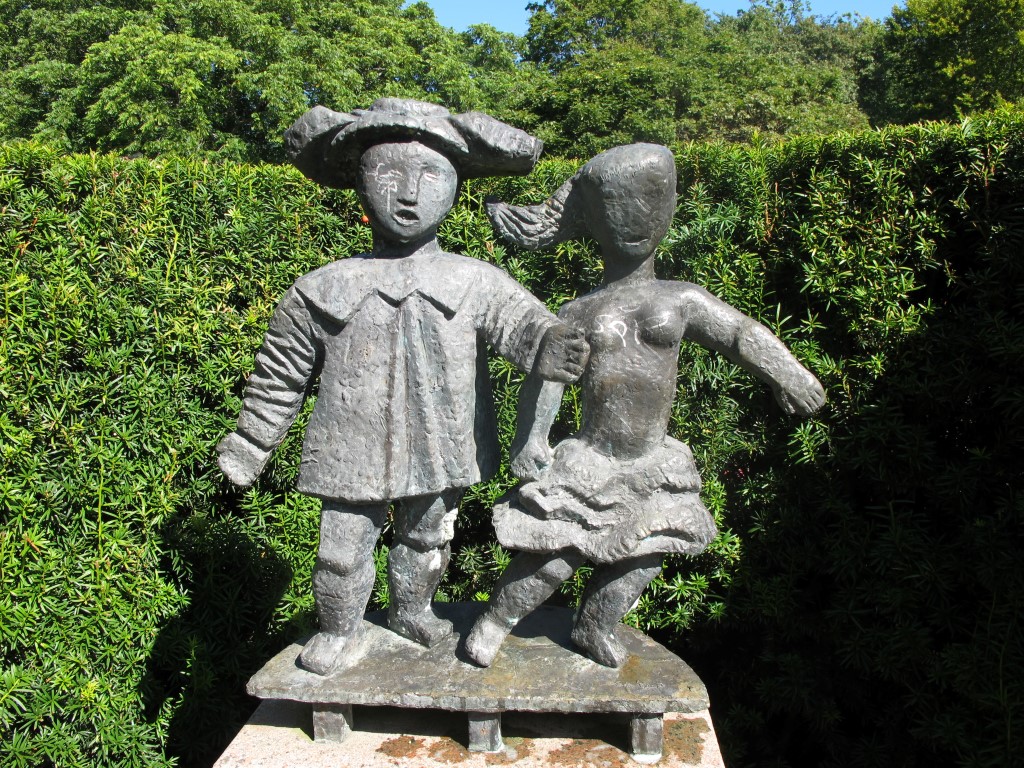Romeo och Julia (Romeo and Juliet)
This is a small sculpture. The two figures in bronze are about a meter high, while the pedestal they stand on is at least one and a half times high. At first glance, the figures look like two children. Romeo wears a shirt with a large collar and a flat hat with wide brims. He stands slightly wide-legged with one arm outstretched and his mouth open.
Julia standing next to him is barefoot and wearing a knee-length ruffle skirt. She's in the middle of a movement. One foot has lifted off the floor and the opposite arm is kept outstretched. The long ponytail flies to the side of the wind. Her features are only hinted at.

Romeo and Juliet – perhaps the most famous play of all time. William Shakespeare’s tragedy tells the story of young love against all odds, and Eric Grate’s sculpture depicts the play’s two main characters. Or does the sculpture instead show two actors playing the lead roles on a small stage?
The man in particular is depicted in a noticeably theatrical pose, and the bodies of both figures have clear child-like features, perhaps to suggest a distance between the theatre’s larger-than-life drama and the actors’ own lives and selves. What do you think about when you see Grate’s figures?
Eric Grate was a sculptor and lived from 1896 to 1983. He became a dignitary in the Swedish art scene and was, among other things, on the board of directors for the Royal Swedish Academy of Fine Arts, the Public Arts Agency Sweden and the Thiel Gallery.
After his studies at the Royal Institute of Art in the early 1920s, Grate spent a lot of time in continental Europe, where he was influenced by both classical sculpture and the modernist art movements of the time, such as cubism and surrealism. He spent nine years in Paris, where he associated with other Swedish artists such as Sigrid Hjertén, Isaac Grünewald, Nils Dardel and Otte Sköld.
So how did it come to be that Romeo and Juliet moved into Stadsparken in 2000, when the artist had been dead for nearly twenty years? According to Gösta Johansson, former secretary of Örebro läns Trädgårdsaktiebolag, the company received a favourable offer from the art foundry where the original sculpture was cast, which still had the mould and could therefore produce a copy of the work.
Konstverk: Romeo och Julia (Romeo and Juliet)
Konstnär: Eric Grate
År: 2000
Material: Bronze
Placering: Magnolia grove in Stadsparken.
Ägare: Örebro läns trädgårdsaktiebolag
Konstverkets position på karta
Publicerad:
Tack för ditt svar!
Berätta gärna vad vi kan göra bättre på den här sidan för att förbättra webbplatsen! Vi har ingen möjlighet att svara, men dina synpunkter är värdefulla för oss. Tänk på att inte skicka in personuppgifter. Om du vill ha svar på en fråga kan du istället använda formuläret ”Lämna en synpunkt”.
Om du ändå skickar in personuppgifter via detta formulär hanteras uppgifterna av Kommunstyrelsen och kan eventuellt lämnas vidare till annan verksamhet inom Örebro kommun i syfte att förbättra vår service.
Här hittar du mer information om hur vi hanterar personuppgifter.
Tack för ditt svar!
Du har nu hjälpt oss att förbättra orebro.se
